很荣幸诸大建教授和我们分享了循环经济的知识和他丰富的经验。事实上,他告诉了我们什么是循环经济,他是如何促进循环经济发展以及中国这些年如何促进循环经济的发展。接着,他也强调了中国和亚洲关于循环经济的一些创举。
Erwan Berger: In the literature, you are often mentioned to be one of the pioneer of circular economy in China. Would you mind giving us a definition of circular economy and sharing with us the key dates of circular economy in China?
Dr Zhu Dajian: In order to provide the lectors with an explanation of circular economy,we can use the diagram of the Ellen MacArthur Foundation (EMF) as a good start.
Today’s liner “take, make, dispose” economy model l relies on large quantities of cheap, easily accessible materials and energy, and is a model that is reaching its physical limits. A circular economy is an attractive and viable alternative that businesses have already started exploring today. A circular economy seeks to rebuild capital manufactured, human, social or natural. This ensures enhanced flows of goods and services, The system diagram illustrates the continuous flow of technical and biological through the “value circle”.
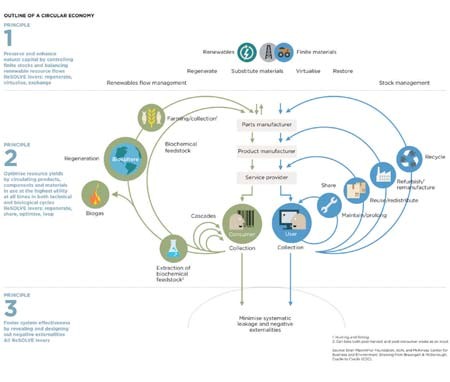
From my viewpoint, I prefer to understand circular economy in detail from three key points of material flows: in input end, circular economy use less finite resource and more renewable resources; in throughput, multi-cycles of materials should be applied to raise resource productivity; and in output end, circular economy aims to avoid waste generation with smart design instead of treating them with landfill and burning. The above explanations of circular economy seems new to most of people as they often regard circular economy narrowly as the recycling of wastes.
I like circular economy as I think that by circular economy China has a great opportunity of leapfrogging and decoupling economic growth from resource consumption and waste generation. The genesis of Circular Economy in China comes from economic researches. We can differentiate 3 periods about circular economy in China:
1998-2002:Circular economy as a new economic model was studied from academic field, with win-win objectives of economy and environment from the perspective of sustainable development.
2002-2005:The Environment Ministry comes to find that circular economy can support the initiative of eco-industry parks so that circular economy becomes one of national environmental protection policies.
2006-Now: China has been facing increasingly serious resource challenges and environmental threats, so circular economy was soon being presented as an alternative development model by China’s Nation Development and Reform Commission (NRDC). This is the real start of circular economy movement in China, which is integrated as a central topic in the five year plan of economic-social development.
EB: Why, what and how can a circular economy be achieved for China?
DZ: First, let us try resource explain why China needs to consider circular economy. You know, since 1978 which was the start of China’s new period of Reform and Opening, every seven to ten years, the Chinese economy doubles, and in the meantime, the need for resources increases proportionally. Thus, China development needs to decouple economic growth from environmental impact, in the beginning only in the sense of relative decoupling of course and nowadays more and more towards absolute decoupling. That is why China has started to look for achieving circular economy in China.
Here after are two graphs for us to look at the trends of China’s economic growth and energy consumption, the second being from www.mdpi.com/journal/sustainability.
China GDP annual growth rate
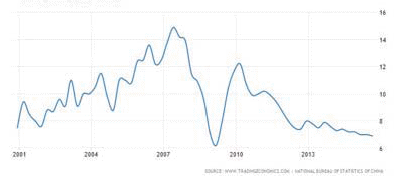
Titre
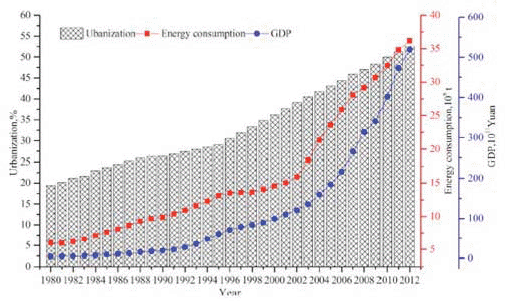
Then, let us define what we are really meaning by circular economy. In fact there are two kinds of understanding about that. Traditionally, circular economy is often seen as waste treatment based on “Reduce, Reuse, Recycle” or 3Rs principle. However, 3Rs is environment efficiency oriented but does not provide an economic perspective whereas circular economy does. Indeed, circular economy is eco-effectiveness oriented with win-win perspective between economy and environment. It can be understood in 3 ways:
Circular economy is of economic significance, which means to save cost and create value from closing the loop of material rather than to spend money for dealing with environmental issues.
Circular economy dose switch from the traditional 3R concept to the new three multi-circles concept:
The waste up-cycle of using materials back to the process of economic supply chain, here I mean that these materials should go back into the manufacture of the same type of product rather than traditional waste recycling outside producers.
The product cycle such as repairing, reusing and remanufacturing or extended product life.
And finally the service cycle such as the sharing economy and product service system(PSS).
The micro level covers single enterprises particularly in high-resource-consumption and high-discharge industries and waste-recycling enterprises.
Recycling enterprises.
The meso level is represented by eco- industrial parks and symbiosis.
The macro level involves cities and regions, including some resource-de-pendent areas in the central and western regions of China, and even large cities with scarce resource like Shanghai and Beijing.
And finally .let us explain how China intends to implement circular economy. China has considered a top down approach with 4 main measures:
China has integrated circular economy as part of the five years plan central issues since 2006.
China released a Circular Economy Promotion Law in 2008 which was enforced in 2009.
China has launched pilot projects covering the various levels (macro level, meso level, micro level). More than 6200 projects were conducted in the past 10 years.
And China has defined indicated in order to assess the resource productivity and de- coupling degree of circular economy. China wants to increase the resource productivity by 15% in the five years plan.
EB: what is the impact of Circular Economy on employment and growth? How can Circular Economy initiatives efficiency be measured?
DZ: In China, the Nation Development and Reform Commission, working with the State Environmental Protect Administration and Nation Bureau of statistics, has published an index system for appraising four aspects of the circular economy:
In future years, with other indicators like total amount of resource consumption and total pollution, these indices will be studied, improved and linked more closely with circular economy targets to measure more effectively the degree of decoupling economic growth from resource consumption and pollutant discharge and raising the ecological efficiency of economic growth.
Generally speaking, circular economy is sustainability and eco-effectiveness oriented, and in this sense it is not only of eco-efficiency but also going to support both economic growth and social employment. In China, CACE estimated that value of waste recycling industries was at the level of 293 billion USD and 20 million jobs was created in 2014,while reducing 1.1 billion tons of solid waste discharge.
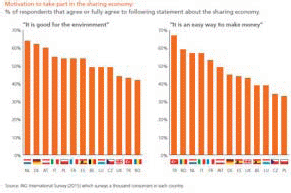
Here above is a survey result from ING about sharing economy from which you could see that it is good enough for both environment and economy.
Anders Wijkman and Kristian Skanberg published a study in 2015 in which they simulated what could be the benefits of circular economy on employment in Sweden. Here under is a recap of this simulation.

EB: china is often mentioned for its emission of CO2(9,019,518 kilo tons & 6.7 metric tons per capita in 2011-world bank ).but not for its politics towards environment. Thus, could you tell us about the initiative of China related to circular economy and the “Five Years Plans”? In addition, how would you comment the national contribution of China for COP21, announced by the Premier of China, Mr Li Keqiang. On June 30th, 2015?
DZ: In my opinion, Circular economy mainly refers to the material cycle and how closing the material loop, whereas the CO2emissions and so COP21, refer to the energy transition and the low carbon renewable energy. Thus it is important to distinguish them which are both parts of the green economy.
Five-Year Plans (FYP) are social and economic development blueprints that were introduced and adopted in China in 1953. This system is a key component of China’s traditionally centrally-planned society and has been instrumental to much of the economic and political success the country enjoys today. Nowadays this is getting more and more like a sustainable development plan and will cover and create a set of targets and guidelines spanning a range of social, economic, and environmental issues that set the nation’s course and articulate the near-term focus of development. These plans are drafted and implemented by central, provincial, local, and district governments, along with industry regulators—each often has their own FYP.
The central FYP is drafted currently by the National Development and Reform Commission (NDRC) and lays out specific ECO targets like GDP growth rates and social development goals in areas such as healthcare and education. In March 2016,China’s National People’s Congress will pass the 13the Five Year Plan .Currently, this FYP Targets are established in consultation with experts from academia, industries, the public and other government ministries. The 13th FYP will guide China towards more innovative, greener and more livable development. Circular economy and low carbon economy will be among key issues of the 13th Five Year Plan (FYP).
EB: implementing a legal frame is also a level to support circular economy implementation. According to you, what could be the ideal legal framework? What are the other levers to support Circular Economy?
DZ: I am deeply involved in various level policy consulting activities in China’s initiative of circular economy and have completed some important policy research projects funded by Chinese Government, including input to framing of circular economy promoting law.
Here above are the policy and law frameworks we would advise for supporting Circular Economy:
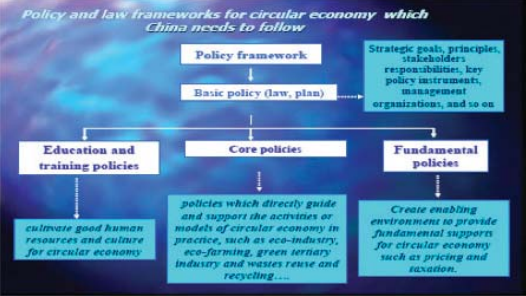
In 2008, The Nation People Congress of China (NPC) introduced a Circular Economy Promotion Law to promote Circular Economy initiatives with three main focuses:
One of the law’s aims is to decouple economic growth from resource consumption and waste generation. Rather than being a simple environmental management policy, circular economy was introduced as a green economy measure and also as a new development model that could help China leap- frog earlier practice to a more sustainable economic structure.
Another focus of the law is to shift from a narrow vision of solid waste treatment to the new idea of closed-loop material flows at all the stages that run from exploitation to production, distribution, consumption and treatment of waste. The law addresses the up-cycling of waste, the reusing of products and parts and the idea that we should be selling services instead of products.
The third aspect of the law has established basic systems to facilitate the development of the circular economy at national, provincial, municipal and county levels, introducing policies and instruments for controlling the total quantities of resource consumption and pollutant discharge, extending manufacturers’ product responsibilities and improving the examination system based on indices of resource input, recycling and pollutant discharge. Contrary to European policy, the Chinese version of circular economy takes a top-down approach and uses command-control instruments rather than market-based ones.
Here are some of the major policies/laws/regulations related to environment and green development.
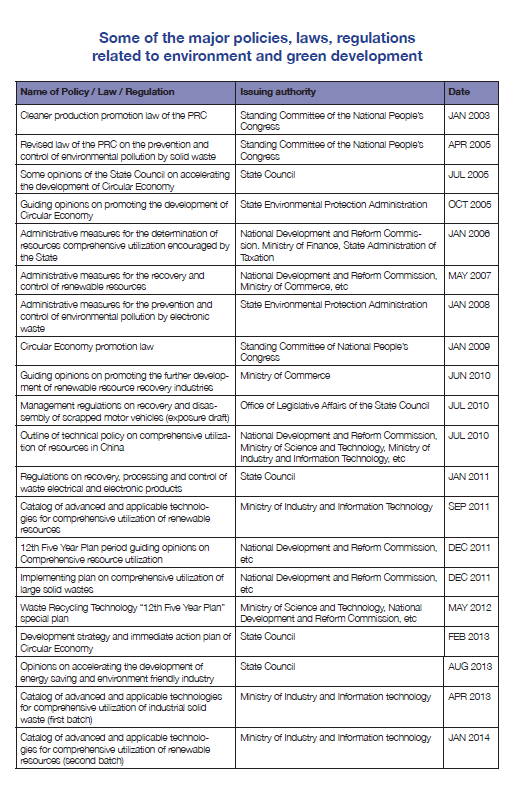
EB: is there any sector (high-tech, apparel, medical industry, automotive, etc.) Which is more active about Circular Economy? Would you mind providing us with some Circular Economy initiatives in China?
DZ: so far, every Chinese province has some projects of circular economy. As highlighted previously, about 6200 projects were conducted in the last 10 years. projects were related to 5 or 6 categories such as recycling industry, remanufacturing, eco-industry parks, resource intensive chemical and steel industry, circular economy cities and regions.
Starting from 1998, as a municipal policy advisor of shanghai, I suggested that circular economy should become one of key issues of Shanghai’s megacity-level sustainable development and green transition, and was involved in the whole process of Shanghai’s framing and developing its circular economyuntil now, including drafting a white book of shanghai circular economy development (2007) and designing priories of action and policies, which made Shanghai become the early bird and pilot city in China to introduce and put circular economy into city development strategy.
Some initiative examples in China are listed here .
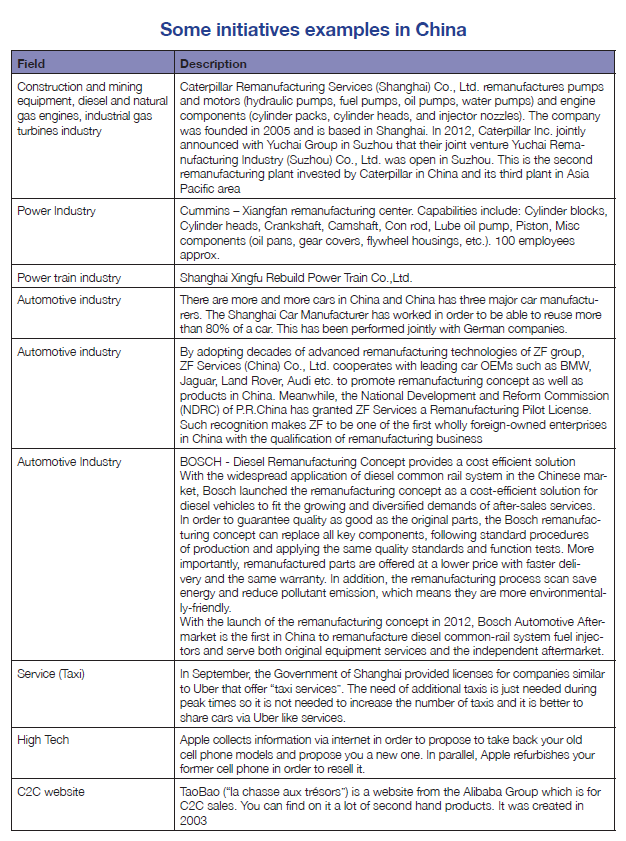
Some of the first ECO industrial Parks and more recent ones are selected here. The list of the other ECO industrial Parks can be found on http://kjs,mep,gov .cn /stgysfyq/m/200807/t20080718_12599.htm.
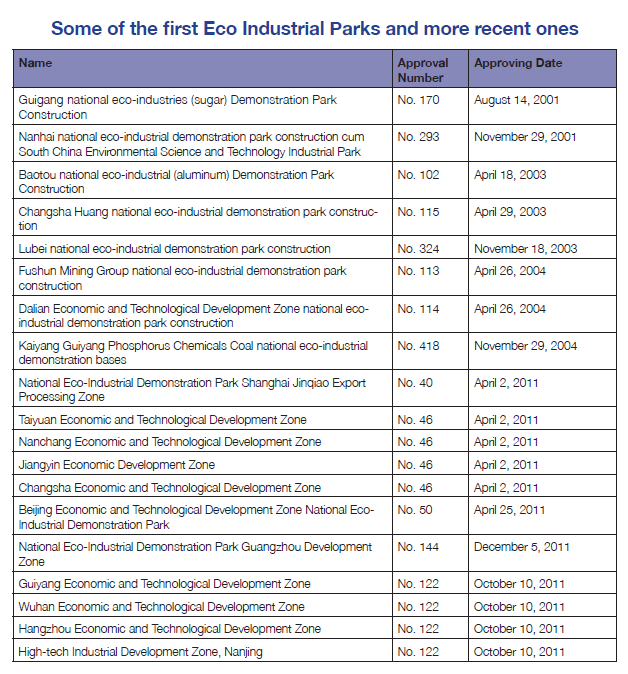
But I must say that currently circular economy is still narrowly pulled by the waste recycle sector in China, so it remains slow in practice in comparison to our wider vision of circular economy. We need to further develop the high-level re-using of products and the product service system. A new group of experimental units has now begun, and China expects to see circular economy practices working nationwide be 2020.by then, more re-manufacturing of auto parts, machinery and product –service systems will be available so as to reshape business available so as to reshape business models along circular economy lines. Among them, the sharing economy should be the highest impact of circular economy initiative.
EB: how would you describe the development of circular economy and qualify the awareness about circular economy in the other Asian countries such as Japan, South Korea, Singapore, Thailand, Indonesia, Vietnam, Malaysia and Philippines? Would you have some initiatives in mind that you could share with us? What is the contribution of the “3R Forum in Asia” to the circular economy?
DZ: I am not involved in circular economy initiatives of the other APAC countries, but I can, of course, list some developments and initiatives that I am aware about.
South Korea has a tradition called “pima-si”, which means “Excel of work” and is often used in the country’s rural side to refer to the reciprocal help among neighbors. Some efforts have been made to restore such a tradition in South Korea and somehow the “Sharing City Seoul” is part of them. Indeed, the “Sharing City Seoul” project started in September 2012, under the leadership of mayor Park Won-Soon. He said that Seoul Sharing City is designed “to make better use of existing resources, both in the city and among its citizens, through sharing “ and “will promote positive social values and allow institutions to enrich the lives of residents with reduced spending “:” There is a way of consuming without possessing.”
Seoul is often called the “world’s most wired city”, knowing that 97% of the South Koreans have a broadband connection and 60% have a smartphone and companies such as Samsung or LG are from South Korea. Thus, this creates ideal conditions to have this tradition be revived and support this project of sharing city.
According to me, sharing economy is the highest category of circular economy and this example of Seoul is really impressive.
Here under are few examples of sharing initiatives:
SoCar is a vehicle-sharing company, based on a “business-to -consumer” business model. The “consumer –to –consumer” business model is still banned in South Korea.
Norizzang is a company dedicated to recycling old furniture. Its 13 employees collect what others discard. Then, they dismantle the cabinets, tables and chairs that they have collected and, with the reclaimed wood, create furniture that can be disassembled for easy transport. They provide low-income communities with their furniture for community activities and workshops. They have even opened a “furniture hospital”, where people can repair broken furniture themselves, with the help of their employees.
The open closet is a non-profit business rents outfits donated by people who no longer have use for them. As an example, students and young professionals can rent an interview outfit.
Kiple is an online platform to exchange kid’s clothes with other parents. You earn some points for any clothe you donate online and you can use this credit to “buy” goods.
Zipbob is an online platform for “social dining”, meeting people with whom you presumably can share interest and experiences and a meal as well-based on the date you entered in you online profile.
ShareHub is a platform where you can get recent information about sharing initiatives in Seoul
South East Asia countries have a GDP growth around 5% per year, a rapidly growing population and an increasing demand of higher living standards with a growing middle consumer class. In addition, the area is one of the most impacted by natural disasters and some of its countries have still a room for improvements in the World Bank indexes such as the logistics performance or ease of doing business ones. Thus, they must look beyond the model “take, make and waste” and look for new models such as Circular Economy.
In early 2015, Accenture, the consultant company, released a report about Circular Economy in South east Asia in which you can find various initiatives :
Singapore’s waste management company Tes-Amm connects seamlessly with its clients’ manufacturing processes to help dispose electronics scrap. It is headquartered in Singapore but operates through a global network of facilities, and it has become the recycler of choice for several large global IT and telecom companies.
PT Enviro Pallets is a company based in Bali, Indonesia that processes plastic waste to create shipping pallets. By offering up to Rp 500(us 5 cents) per kilogram of plastic waste, it effectively incentivizes locals to help clean up rivers, beaches and grounds from mounds of plastic rubbish, and uses this up as feedstock. With this clever business model they aim to process 30% of plastic waste generate in the island.
In Singapore,the Sustainable Manufacturing Center (established in 2009) and the Advanced Remanufacturing and Technology Centre (launched in 2012) have been longevity of products through topics such as green manufacturing, remanufacturing, repair and restoration and product verification.
Tripid, a ride sharing service based in the Philippines, connects drivers and passengers headed the same way. This platform helps create a community of drivers and passengers who opt to share rides with others, while also allowing users to act as drivers for others looking for a ride.
Singapore based business BlockPooling leverages the idea of sharing platform in a community. In this densely populated country where most people live in high rise buildings, this business not only allows individuals to exchange goods, services or information with their neighbors, but also to connect with each other socially, thus creating loyalty and stickiness that contributes to its success.
In a heartwarming example of a sharing platform, Malaysia based “Plate Culture” has brought homemade food sharing to several countries in ASEAN. It allows home kitchen chefs to enlist their menu and prices on the site, so that users tired of restaurant grub can stop by for a homemade meal.
Sunlabob,s solar enterprise based out of Laos has created a service based approach to sustainable lighting I rural areas . in off grid villages where people use candles or oil lamps, solar lamp rental has become an increasingly popular business model, where a central enterprise rents out solar lamps on a daily /weekly basis for a fee, thus providing “lighting as a service”. Compared to solar home systems where individuals buy /lease an entire solar panel and related equipment, this service based approach provides better affordability to villagers and also ensures batter maintenance and efficiency of the equipment.
Singapore based tyre manufacturer Omni United has tied up with US footwear company Timberland to create a special line of tyres that can be easily recycled at end of life into crumb rubber to be used by Timberland for making shoe outsoles. This innovative partnership overcomes Timberland’s earlier issues of not being able to get a steady supply of recycled rubber in consistent quality.
I would also like to highlight the regulations that Singapore Government put in place to reduce and control the packaging waste. Indeed, the National Environment waste. Indeed. The Nation Environment Agency launched the Singapore packaging agreement (spa) in 2007 as the key program for managing packaging waste, which make up one-third of Singapore’s domestic waste disposed of by weight. Through the SPA businesses commit to effect changes to their packaging designs, practices and/ or processes to reduce packaging waste. As of October 2015,there are 164 Singapores,26 000 cumulative tons of packaging waste reduced and 58 million SGD in savings over a 8 years period.
Japan has always faced natural resource scarcity due to geological and geographical limits and so has been considering these constraints and promoting 3R (reduce, reuse, recycle ) since years. Thus, Japan has focused its efforts on three topics. The first consisted of structural adjustments to reduce dependency on oil as a single energy source, and optimize industrial structure to improve the efficiency of energy utilization within industries. The second step involved legislation for environmental policies, establishing a comprehensive legal system, regulating waste management, and standardizing the approach to addressing violations. The third was increasing societal participation through education and public awareness campaigns. Japan’s recycling rate for metal is 98%,and is also high for other materials. In 2007,only 5% of Japan’s waste went into landfill. The majority of electronic appliances/ electrical products are recycled, and up to 89% of materials they contain are recovered. As a rule, recovered materials are used to manufacture the same type of products.
Japan has setup three indicators of which the goal is to reduce the total amount of waste upfront from the waste recycling. These indicators are:
The rate of the waste treatment
The rate of the recycling
The total amount of waste
Here under are some examples of Circular Economy in Japan:
Ricoh .the Japanese multinational for imaging and electronics, established the Comet circle in 994 to reduce the environmental impact of their products. The program’s primary directive was that all product parts would be designed and manufactured so that they could be recycled or reused. The company also established the GreenLine label as concrete expression of its commitment to resource recirculation, which is a huge success story today. In addition to remanufacturing, the company refurbishes and upgrades pre-owned machines. For products that cannot be remanufactured, Ricoh harvests the components and recycles materials at local facilities.
Established in July 2000,Socueus is an online market for the “social exchange “of a wide variety of items and services, including books, CDs, clothing, furniture, electronics, artwork, vehicles, etc.
Wire Mama Network is a multi-presence online market place for the free-of charge sharing of baby products that have only been used for a short time. There are currently ten Wire sites, each facilitating the local sharing of used baby goods the first of which was established in Kunamoto into 2001
CaFoRe is a national online platform for the sharing of vehicles aimed primarily at individuals. Users register on the site as either a “lenders” or “borrower” ABS the site provides the necessary legal and the necessary legal and contract framework, plus an online reservation system
Shibukasa , established in December 2007, focuses on just one product and in a specific part of Tokyo. The website platform is dedicated to the sharing of umbrellas across the Shibuya ward to the capital
EB: what are the strengths and weaknesses of the existing legal framework in china, India and Europe?
DZ: China schemes do not only cover waste treatment but also is about eco-design into businesses. Indeed, China Circular Economy Promotion Law is really a new model. Thus, in comparison to Germany and Japan Laws, the approach is different.
Of course, China Circular Economy Promotion Law was setup in 2008 and implemented in 2009. From my personal viewpoint, it had some weaknesses and gaps between our vision and practice:
In fact, we may distinguish two types of Circular Economy, the older about waste recycling and the new one about eco-design with the objective of reducing waste. The China law covers these two types, but it is still more about waste recycling. Thus we need to pay more attention to eco-design and strengthen it in the revised version.
During the last ten years, the circular economy was driven by the government in China. However, it is critical to switch to a business driven model, which means to switch from a “spend money” to a “save money or make money “way of thinking. Eco-design is also related to extended producer responsibility. Indeed, experiences demonstrated a bigger focus of producers on eco-design when they are responsible / involved in the recycling of their products.
In the term of policy instruments, you can increase crease taxes for the things which are not in favor of environment and release taxes for the things which are in favor of environment. So, the question is about how to create some market-based instruments or an eco-tax such as in Germany in order to stimulate circular economy.
In India, circular economy in the meaning of closed material loop is still weak. Thus it is difficult to make any comparison.
EB: how important are universities such as “Tongji University “where you are working, associations such as the “China Association of Circular Economy- CACE” for promoting circular economy, and foundations such as the “Ellen MacArthur Foundation”? What has been and is the role of the education for circular economy?
DZ: Circular economy comes from academic studies of sustainable economy and green economy. Thus, research fellows and universities have played and play an important role for circular economy. In addition, universities make sensitive and educate students about circular economy and so build the foundations for the future and support the development of circular economy.
For me as an example to encourage the development of Circular Economy in China, I did several things as follow:
I translated Walter Stahel’S book performance economy into Chinese (2009),recommended and spread ideas of McDonald and Braungart’s book Cradle To Cradle(2002), and wrote prefaces to Chinese versions of Paulis Blue Economy(2012) and Weizsacker’s Factor Five (2012).
I organized an international forum, invited stahel and some other key advocates of circular economy to discuss and compare commons and differences between China’s and their concept of circular economy ,ad tried to do some things of integration and synthesis.
I traveled far and wide around China and gave public speeches for more than several hundred times to share knowledge of circular economy with government, business , academics and general audience .
I wrote a lot of articles on the newspapers and made many TV talks to spread this new model to the public and explain its significance for China
I introduced theory, methods and cases of circular economy into EMBA, MBA and MPA programs, set up a sustainable business management course with circular economy and low-carbon economy as key issues, and developing a teaching and research team of sustainable business management for Tongji University and some other universities in China .
As a chair professor of green economy from UNEP-Tongji Environment and Sustainable Development institute, give regular lectures about circular economy annually, and in 2014-2015.
Working with UNEP’s experts, we have published a book Green Economy-Theory ,Methods and Cases from the United Nations’ Perspective , in which circular economy is considered and studied as an important element of green economy
The CACE was created in 2011 and organizes a yearly conference that gathers roughly 1000 attendants, of which most are from business, especially from waste industry.
The “Ellen MacArthur foundation “(EMF) organizes conferences, assembles universities and companies, publishes books and studies, and supports the designs of courses in schools and universities. In this way, the foundation really promotes circular economy and helps have people know about it. Tongji is one of he 14 EMF key university partners cross the world .
EB: According to you, what are the main challenges of circular economy, But also its barriers (if any )? Could you try to provide us with a glimpse of the Circular Economy future?
DZ: Let me say about this separately for China and the World. As I mentioned before, China is now dealing with the 13th five years plan and the main challenges for circular economy initiative would be as follows:
Control the amount of waste generation and increase the resource productivity rapidly in the next decade when economic growth would be doubled;
Involve more stakeholders into green economy transition and create a circular economy oriented business model;
Take into account the entire product life cycle and implement a product service system which means to “switch attention from the waste loop to the product loop”.
For the world, United Nation has defined for 2015-2030 the Sustainable Development Goals which is a set of 17 goals and 169 detailed targets. However, sustainable development is a very big umbrella. We, in practice, need circular economy as a useful method and tool to sustainable development. In my opinion, circular economy covers the three pillars of sustainable development, social, environment and economy, and should be given more attention from policy-makers and business people.
At the moment when Western People talk about circular economy, they often think this is something of waste recycling. In the last ten years, many new theories were produced about circular economy rather than waste recycling. Now for the next ten years, we need to unify all these theories into a general paradigm. The “Ellen MacArthur foundation and the World Economic Forum are a good framework to promote circular economy along the World focusing on a new economy by eco-design. I am very happy to be involved in the related initiatives of circular economy under world economic forum and EMF. We all agree that critical economy is a new economy model and that is should be more integrated and embedded in the production and consumption. So, it is important to let officials, business and the society know that critical economy is much than traditional waste recycling . I hope this interview could be going to contribute to this big green transition.
【原文PDF】
 Circular economy A new economic model for China and the World.pdf
Circular economy A new economic model for China and the World.pdf

